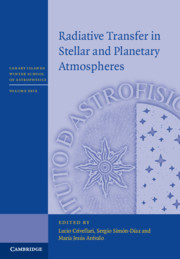Book contents
- Frontmatter
- Contents
- List of Contributors
- Preface
- Acknowledgements
- 1 The Physical Grounds of Radiative Transfer
- 2 Fundamental Physical Aspects of Radiative Transfer
- 3 Numerical Methods in Radiative Transfer
- 4 Stellar Atmosphere Codes
- 5 Radiative Transfer in the (Expanding) Atmospheres of Early-Type Stars, and Related Problems
- 6 Phenomenology and Physics of Late-Type Stars
- 7 Modelling the Atmospheres of Ultracool Dwarfs and Extrasolar Planets
5 - Radiative Transfer in the (Expanding) Atmospheres of Early-Type Stars, and Related Problems
Published online by Cambridge University Press: 24 December 2019
- Frontmatter
- Contents
- List of Contributors
- Preface
- Acknowledgements
- 1 The Physical Grounds of Radiative Transfer
- 2 Fundamental Physical Aspects of Radiative Transfer
- 3 Numerical Methods in Radiative Transfer
- 4 Stellar Atmosphere Codes
- 5 Radiative Transfer in the (Expanding) Atmospheres of Early-Type Stars, and Related Problems
- 6 Phenomenology and Physics of Late-Type Stars
- 7 Modelling the Atmospheres of Ultracool Dwarfs and Extrasolar Planets
Summary
In many cases, the quantitative spectroscopy of early-type stars requires to account for their line-driven winds, and theoretical models of such winds are based on a consistent calculation of the radiative line acceleration. Both topics ask for a thorough understanding of radiative transfer in expanding atmospheres. In this chapter, we concentrate on three issues, and compare, when possible, with corresponding results forplane-parallel, hydrostatic conditions: First, we investigate how sphericity alone affects the radiation field in those cases where Doppler shifts can be neglected (continua). Subsequently, we consider the impact of velocity fields on the line transfer, both by applying the so-called Sobolev approximation,and by presenting the more exact comoving-frame approach. Restrictions and extensions of both methods are discussed. Finally, we concentrate on the coupling between radiation field and occupation numbers via the NLTE rate equations. We illustrate the basic problem within the conventional Lambda Iteration, which is then solved by means of the so-called Accelerated Lambda Iteration (ALI), and by a "preconditioning" of the rate equations.
Keywords
Information
- Type
- Chapter
- Information
- Radiative Transfer in Stellar and Planetary Atmospheres , pp. 151 - 190Publisher: Cambridge University PressPrint publication year: 2020
